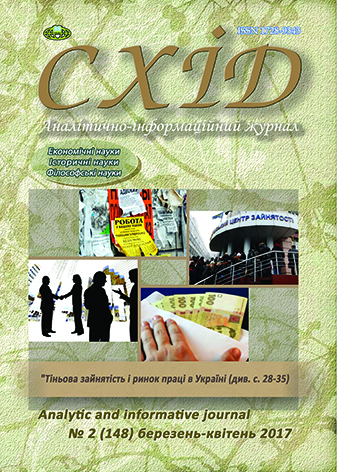The picture of the world as a part of social reality
DOI:
https://doi.org/10.21847/1728-9343.2017.2(148).102805Keywords:
social reality, picture of the world, general scientific picture of the world, specially scientific picture of the worldAbstract
The most relevant term to describe initial situation, in which the person of modern world can find himself today, is a social reality, definition of which was given by Alfred Schutz, a follower of Edmund Husserl. Though there's a need to make his term more accurate: both cultural and social institutes and natural world can be considered as elements of reality's model, but the social reality itself isn't identical to this (its own) model. In most everyday and traditional situations person can only have ritual thinking and not create explicit images of the "whole", which contains these situations. It means that everyday practices are not necessarily connected to the system, however the complex of significant social institutions and traditions give person enough number of practices-rituals, which allow him and his group to set boundaries of these practices' effectiveness (boundaries of normality) and preserve their cultural universum in time.
By mastering during the process of initial socialization ways to identify socially significant values and modes of action ("rituals") according to these values the person is learning and forming a mental image of environment, which allows him to reproduce and translate his accumulated cultural experience. Complex of subjective skills and abilities allows person find himself at each moment of his life in some "real situation", forms of which are directed by society. Kaleidoscope of life situations, which bases on person's conscious and unconscious action (starting from controlling the moves of own body, use of objects and their identification, articulation of dangerous, desired etc. to special practices), more or less repetitive from person to person (i.e. intersubjective by their nature) and followed with certain mental images (which include interiorized view on significant things) should be considered as a social reality.
Downloads
References
Alekseev, I. (1981), Quantum mechanics and the ideal of physical explanation, Ideals and norms of scientific research, Publishing house of theBelarusianStateUniversity. Minsk, 431 p. (rus).
Ajdukiewicz, K. (1978), The World-Picture and the Conceptual Apparatus, The Scientific World-Perspective and Other essays 1931-1963, Dordrecht, Reidel, 1978, pp. 67-89. DOI: 10.1007/978-94-010-1120-4_3
Gryaznov, A. (1990), Natural Language and Understanding of Cultural and Historical Phenomen, Misunderstood Mind, the Variety of Non-scientific Knowledge, Moscow, pp. 239-255 (rus).
Zandkuler, H.Y. (2002), Representation, or How reality can be understood philosophically, Voprosy Philosophii, No. 9, pp. 81-90 (rus).
Lakatos, Imre (2003), History of science and its rational reconstruction, Methodology of research programs, «AST»& «Ermak» Publishing, Moscow, 380 p. (rus).
Lakatos, Imre (2009), Deductivist versus heuristic approach, Epistemology & Philosophy of Science, Vol.20, Issue 2, 21-225. DOI: 10.5840/eps200920275.
Polanyi, Michael (2015), Personal Knowledge. Towards a Post-Critical Philosophy, University of Chicago Press. DOI: 10.7208/chicago/9780226232768.001.0001
Porus, V. (1983), Actual problems of the analysis of «scientific revolutions»: (Analytical reviews of foreign literature). Analyte. Reviews of foreign countries. Lit. [To the XVII World. philosopher. Congress, Montreal, 21-27 Aug. 1983], IFAN Publishing, Moscow, 110 p. (rus).
Porus V. (1981), «Scientific Realism» by William Sellars and his evaluation in modern Western philosophy of science (review), New Trends in the Foreign Philosophy of Science. Collection of reviews and abstracts, Moscow (rus).
Pugachev, N. (1983), Problems of ontology in the philosophical analysis of scientific knowledge, Gnoseology in the system of philosophical worldview, Nauka Publishing, Moscow, pp. 60-90 (rus).
Stepin, V. (1981), Ideals and norms in the dynamics of scientific research, Ideals and norms of sciele antific research, W.p., Minsk, 1981, pp. 10-64 (rus).
Stepin, V. (1979), Structure and evolution of theoretical knowledge, Nature of scientific knowledge: Logical-methodological aspect, Publishing house of BSU, Minsk (rus).
Stepin, V. (2000), Theoretical knowledge. Structure, theoretical evolution, Progress - Tradition, Moscow (rus).
Stepin, V. (2011), Civilization and Culture, SPbGUP Publishing, St.Petersburg, 408 p. (rus).
Feyerabend, P. (1986), Selected Works on the Methodology of Science [translat.], Progress, Moscow, 544 p. (rus).
Holton, Gerald (1993), Science and Anti-Science, Harvard Univ. Press, Cambridge, p. 203 (eng).
Holton, Gerald (1981), Thematic analysis of science [translat.], Progress, Moscow, 383 p. (rus).
Hüner, Kurt (1994),Criticism of the scientific mind [translat.], Electronic publication: Center for Humanitarian Technologies, available at: http://gtmarket.ru/laboratory/basis/5200
Schutz, А. (1954), Concept and Theory Formation in the Social Sciences, The Journal of Philosophy, Vol. LI. N 9. April 29. Pp. 257-273 (eng).
Downloads
Published
How to Cite
Issue
Section
License
Copyright (c) 2017 Aleksandr Belokobylskiy

This work is licensed under a Creative Commons Attribution-NonCommercial-NoDerivatives 4.0 International License.
1. Authors bear responsibility for the accuracy of facts, quotations, numbers and names used.
2. Manuscripts are not sent back.
3. The publisher does not always agree with the authors' opinion.
4. The authors reserve the right to authorship of the work and pass the first publication right of this work to the journal under the terms of a Creative Commons Attribution-NonCommercial-NoDerivatives 4.0 International License. This license allows others to distribute (copy) the published work for non-commercial purposes, provided there is mandatory attribution to its authors and a link to the first publication in our journal.
5. The authors have the right to conclude separate supplement agreements that relate to non-exclusive work distribution in the form in which it has been published by the journal (for example, to upload the work to the online storage of the journal or publish it as part of a monograph), provided that the reference to the first publication of the work in this journal is included.

